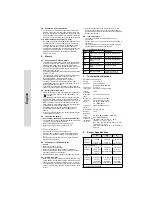
1
What is what
2
Standard configuration
1)
3
Safety advisory
— The use of the Dräger Pac 5000 instruments assumes a
complete knowledge and adherence to the users manual.
— The Pac 5000 may only be used in areas subject to
explosion hazards which are explicitly covered under the
Ex Approvals which have been given to the Pac 5000.
— Pac 5000 is not for use in oxygen-enriched atmospheres.
— Please check calibration before safety relevant use.
— The performing of calibration and bump testing shall be
conducted according to local regulations.
— Dräger Safety AG & Co. KGaA is not responsible for
damages incurred when the above guidelines are not
explicitly adhered to.
4
Intended Use
— Personal gas alarm in the workplace.
5
Operation
5.1
Remaining life of the instrument
— Once activated check the remaining life by pressing [+]
while instrument is turned off. The gas to be measured will
be shown. After another press “d” will be shown.
After another press the remaining time in days will be
shown, e. g. “CO”, “d”, “750”.
_____________
1) Please be aware of special settings by customer requirements.
2) For O
2
A1 is the lower alarm threshold, used to indicate oxygen deficiency
1
Alarm LED
6
Gas Opening
2
Horn
7
Screw
3
Concentration Display
8
Clip
4
OK Key On/Off/Alarm Acknowledge
9
Label
5
+ Key Off/Bump Test
CO
H
2
S
O
2
Order No.
Measuring Range
0 to 500
ppm
0 to 100
ppm
0 to 25
vol.-%
Vibrating alarm
Yes
Yes
Yes
Alarm Threshold A1
30 ppm
10 ppm
19 vol.-%
2)
acknowledgeable
Yes
Yes
No
latching
No
No
Yes
Alarm Threshold A2
60 ppm
20 ppm
23 vol.-%
acknowledgeable
No
No
No
latching
Yes
Yes
Yes
Display
numeric
numeric
numeric
Life Signal
on
on
on
Turning the
instrument off
always
allowed
always
allowed
always
allowed
2
7
9
7
8
4
1
3
1
7
7
6
5
00
123806_1
.eps
5.2
Activating a new instrument
— Press and hold [+] for approximately 3 seconds while
“3, 2, 1“ appears in the display. The instrument’s usable
life is now started. The number of days remaining is
shown in alternation with “d” until the + key is released.
e.g. “750”, ”d”, “750”, “d”, ...
5.3
Turning the instrument on
— Press and hold [OK]. The display counts down until
startup: “3, 2, 1”.
— All display segments are lit. Next, the LED, Alarm and
Vibrating alarm are activated in sequence. Please check
these before each use.
— The instrument will perform a self test.
— The software version and the gas name are displayed.
— The number of days of remaining operation are shown,
e. g. “750”, “d”.
— The A1 and A2 alarm limits are displayed.
— When the instrument is first activated, a sensor warm up
time of up to approx. 5 minutes is needed. The gas name
flashes until the warm up time has passed.
5.4
Before entering a working place
— After turning the instrument on, the gas name to be
measured will normally be shown in the display.
— Check for the notice icon [!]. When lit, it is recommended
that you perform a bump test as described in section 5.5.
— Clip the instrument to clothing before working in or near
potential gas hazards.
— Insure that the gas opening is not covered and that the
instrument is also near to your breathing area.
5.5
Performing a “bump test” with gas
— Prepare a Dräger test gas cylinder with 0.5 l/min and a
gas concentration higher than the alarm threshold to be
tested.
— Connect Pac 5000 and the test gas cylinder to the
calibration adapter or to the Dräger Bump Test Station.
— To achieve the bump test mode press and hold [+] for
3 seconds. The instrument beeps twice, quickly. The
Display begins to flash slowly. Release [+].
— Open the regulator valve to let test gas flow over the
sensor.
— If gas concentration exceeds the alarm thresholds A 1 or
A 2 the corresponding alarm will occur.
— To finish the bump test press [OK] for 1 second, the [!]
icon is removed from the display and the instrument
returns to the measuring mode.
— If during the bump test no alarm occurs within 1 minute,
the instrument beeps three times to indicate failure. The
[X] icon is lit; error code 240 is shown for 10 seconds.
Afterwards, “-- -- --“ is shown instead of the gas name, and
the [X] icon stays lit. In this case the bump test can be
repeated or the instrument can be calibrated.
— The result of the bump test (passed or failed) will be
stored in the event logger (see section 5.8).
— The bump test can also be made by an automatic function.
This function can be activated using the PC software
Pac Vision or CC Vision (see section 5.9).
5.6
During operation
— If the allowable measurement range is exceeded or a
negative drift occurs, the following will appear in the
display: “_ _ _” (too high concentration) or “___” (negative
drift).
— Alarms are indicated as described in section 6.
— Continuous function of the instrument is indicated by the
life signal, which is a beep every 60 seconds, if
configured (see section 2).
5.7
Turning the instrument off
— Simultaneously hold both keys for approximately 2
seconds until “3” appears in the display. Continue to hold
both keys until the countdown is finished. The alarm and
LED will be activated momentarily.
5.8
Event logger
— Pac 5000 is equipped with an event logger. The event
logger stores 60 events. If event No. 61 occurs the logger
overwrites the oldest stored event.
— For download of the stored data connect Pac 5000 to a
PC using the connecting cradle or the E-Cal System. The
stored data can be downloaded with installed software
Pac Vision or Gas Vision.
English



